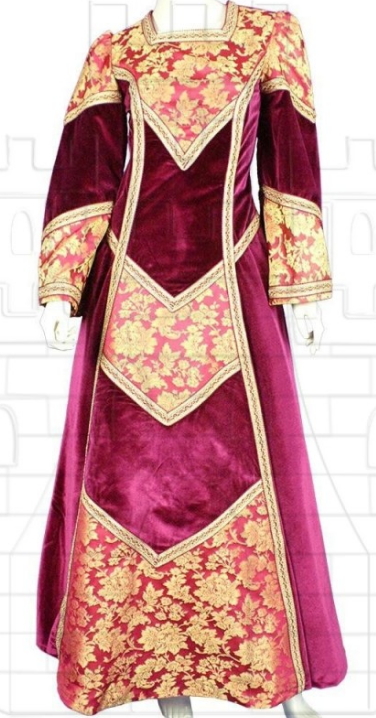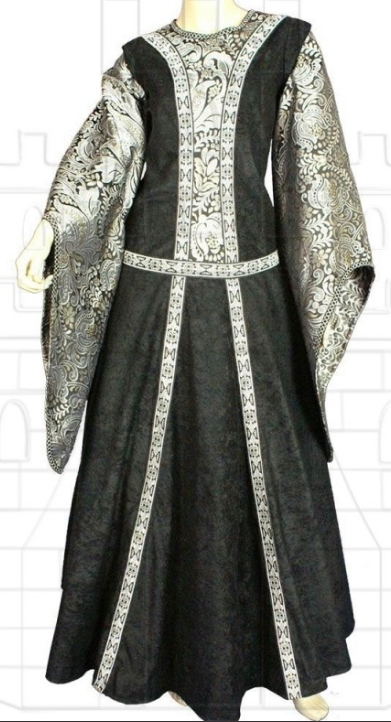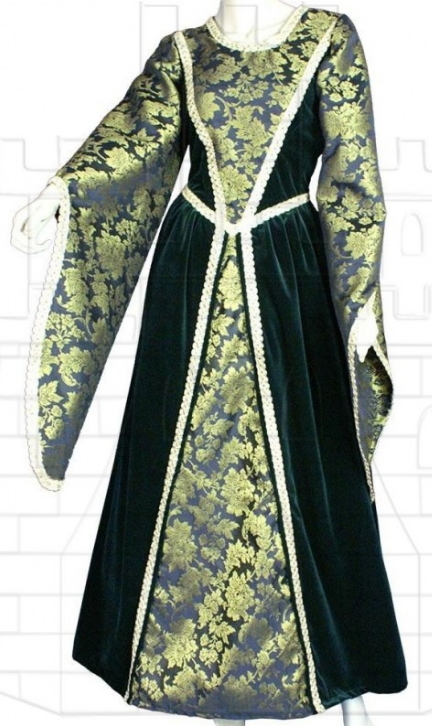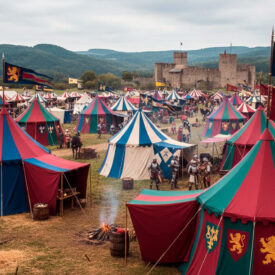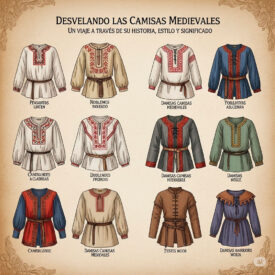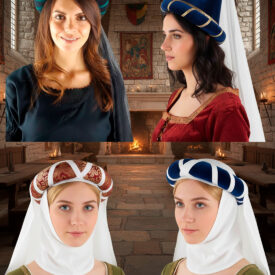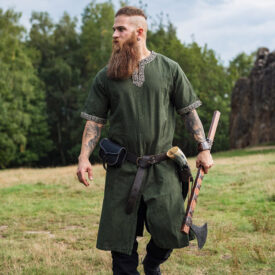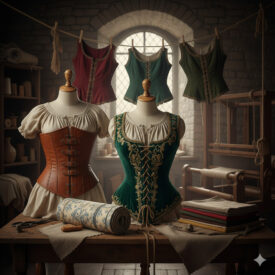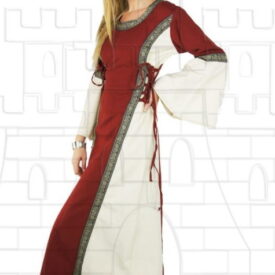Delving into the fascinating world of medieval dresses for women is much more than exploring the fashion of an era; it is about understanding a complex social system where clothing was a language, a statement of identity and status. In the Middle Ages, every fold, every color, and every fabric of a woman’s dress told a story about its wearer, her family, and her position in the social hierarchy.
Far from being mere coverings, medieval women’s clothing—especially that of courtly ladies—stood as a symbol of status and sophistication. A simple glance could distinguish a noblewoman from an artisan, and these differences were not a matter of personal taste but were often dictated by strict sumptuary laws. These regulations determined which fabrics, colors, and embellishments each social class could wear, preserving social order and controlling excessive luxury.
Luxury as a Social Distinction: Fabrics and Colors in Medieval Dresses
Access to certain materials and dyes was a privilege of the upper classes. While less privileged people made do with the natural colors of fabrics, such as gray or brown, courtly women adorned themselves with a vibrant and striking palette. The ability to produce these vivid colors, which required more dye, was a clear sign of purchasing power. Shades such as lilac, scarlet, sky blue, blue, gold, red, silver, pure green, and purple adorned the medieval women’s dresses of the elite.
It is important to note that purple, due to its rarity and the complex process of its production, was reserved exclusively for the nobility. The importation of indigo and the development of scarlet dye in the Late Middle Ages further expanded this luxury palette, allowing for greater expressiveness in medieval women’s dresses.
As for fabrics, opulence was the norm for the upper classes. Silk embroidered with gold and trimmed with exotic furs was common. In addition to silk, velvet and brocade were highly valued materials. High-quality linen and fine wool also found their place in noble garments, and even felt and muslin were used for certain creations. In contrast, peasants and serfs kept warm with linen, wool, or cheap furs. An interesting fact is that the length of garments was also a sign of status: the longer the dress, the more noble the wearer.
Key Garments in the Medieval Court Lady’s Wardrobe
The medieval women’s wardrobe, particularly in the Hispanic kingdoms of the late 12th and early 13th centuries, although simple in cut, achieved remarkable sophistication that spread throughout Europe. This elegance was reflected in every layer, from underwear to the most sumptuous outerwear.
Underwear: The Foundation of Medieval Dress
- Chemise or Alcandara: This was the universal garment and the starting point of every wardrobe. For noblewomen, it was made with fine cotton or very delicate linen thread, often with necklines and sleeves profusely embroidered with geometric or floral motifs of Andalusian tradition. In exceptional cases, these embroideries were made with gold and silver threads. It could be loose with wide sleeves and tight cuffs, or more fitted, with long sleeves tight to the arm.
- Hose: Although it was uncommon for women to cover their legs with hose, noble girls did wear them. They were made of linen or high-quality wool, or occasionally silk. Preferred colors were white, green, red, orange, and blue.
Main Garments: The Heart of Medieval Women’s Dresses
- Saya: This garment was always worn over a chemise, never directly on the body (except by the very humble). For noblewomen, it was very long, always covering the shoes, and extremely loose, with numerous pleats in the bodice and skirt. The sleeves were very long but narrow, often pleated. Materials included high-quality linen or wool, and exceptionally silk, with brocades of geometric motifs and rich embroidery on the bands at the hem and sleeves. The neckline was usually of the “amigaut” type.
- Laced Saya: Very popular, especially in the Hispanic kingdoms, to accentuate the slenderness of the waist with side or back lacing. It could have sleeves or not (sometimes detachable), allowing the rich embroidery of the inner chemise to be displayed. It was made with high-quality linen, silk textiles, and rich fabrics, and was worn with a pellote or cloak.
- Brial: Very widespread in the 12th century and persistent in the 13th. Similar to the saya but always made with rich fabrics such as ciclaton or samite and with luxurious embroidery. It was a long and loose garment, often with side openings and lacing, and could have long, narrow (pleated) sleeves or be sleeveless. Always worn with a cloak.
Outer Garments: Coats and Cloaks that Completed the Look
- Pellote: A sleeveless garment worn over the saya or brial. For the nobility, it was very long, sometimes with a train, and with an open neckline. It was made of rich fabrics such as lampas or brocades, and with gold and silver threads, often with geometric motifs.
- Pellizón (Misha): Outer garments lined inside with fur. They could be long to the feet or shorter to show the saya underneath. They were loose, with long and often very wide sleeves, which could be tied at the ends. In the 13th century, their use was associated with solemn ceremonies, such as weddings and coronations, and in Al-Andalus, they were reserved for mourning. They featured rich embroidery on sleeves, neck, and skirt. Ermine, marten, otter, and sable furs were exclusive to the wealthy classes.
- Garnacha: Similar to the pellizón, but made of sturdier fabrics and with an inner lining, making it looser. For noblewomen, they were long enough to cover the feet, with short or no sleeves, and often lined with fur (such as squirrel in Navarre).
- Cloak or Mantle (Qisa): A very common outer garment, which could be worn covering the head and shoulders, fastened centrally with a brooch, simply thrown over the shoulders, or over one shoulder. Noble cloaks were generally lined with luxurious furs and were long to the feet, matching the inner garment. The cords to fasten the cloak at the neck could be braided with gold threads.
Accessories: The Detail that Made the Difference in Medieval Women’s Dresses
Accessories were the finishing touch for any outfit, and like the main garments, were powerful symbols of status and wealth.
Belts
For women, belts were always narrow (less than 3 cm) and lacked obvious metal appliqués or decorations. They could be made of natural leather or tanned in light colors. Noblewomen often used woven ribbons with expensive threads such as silk, gold, and silver, while the middle classes used wool threads. They were recommended for cinching pellotes and sayas, but not with garnachas.
Headwear: The Art of Covering the Head
Hispanic Christian tradition required married women to cover their heads (“capite velata”). Only maidens, female minstrels, and dancers could wear their hair uncovered, often styled in braids or adorned with a ribbon or garland.
- Veil (Miqna’a): The simplest form was a rectangular or semicircular fabric veil over the head and shoulders. There was a great acceptance of translucent and transparent fabrics, a clear Andalusian influence.
- Fitted Veil: Of oriental origin, this veil completely covered the face except for the eyes, hiding ears and neckline. It was made with a wide piece of rectangular fabric, heavily pleated, leaving only the face visible. The more pleats, the richer the veil. Silk or very fine linen was used, with edges trimmed in gold or silver threads. Black was common for widows and nuns.
- Almaizar: A kind of turban with a chin strap, of Andalusian influence. It was worn by both humble and noble women, associated with widows and mourners.
- Pleated Cap: A sophisticated headpiece with an inner parchment structure, wrapped with a very long band (up to 6 meters) of fine silk (cendal) or crimped and gathered muslin, fixed with pins. By the mid-13th century, it allowed partial display of hair, either in a bun or loose.
- Garland or Ribbon: Ornaments for loose or braided hair of maidens and dancers, which could be made of wool or be very luxurious with tinsel and precious stones.
- Travel Hats: There are no references to hats for women until the second half of the 13th century, and they were mainly used for outings to the countryside or travel, being identical to men’s (straw cones).
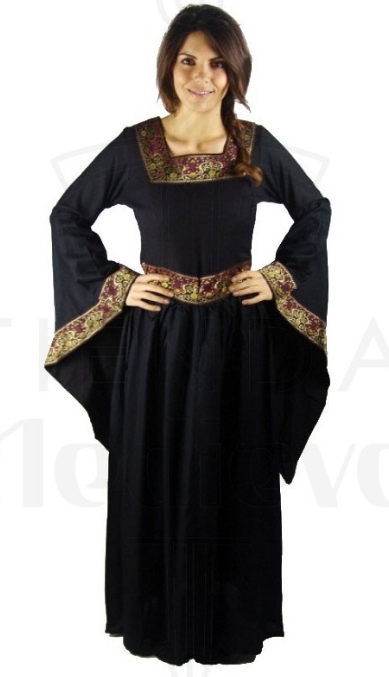
Footwear: The Feet of the Medieval Lady
Both sexes wore a kind of open leather slippers.
- Slippers: Very fine leather footwear, cordovan, sometimes decorated with gold, exclusive to the wealthy classes. Their use was forbidden to the Mudéjar and Jewish populations.
- Zabatas: A type of ankle boot, suitable for the street and worn by all social classes, varying in quality.
- Openwork Shoes: With decorative openings and perforations that revealed the hose underneath. Richly perforated for the nobility.
- Low Shoe: Closed footwear that hardly differed between men and women and was used by all classes. Often adorned with a central cord on the instep.
The Evolution of Luxury: Medieval Dresses from the 14th to the 16th Century
Especially from the 14th to the 16th centuries, with the consolidation of European kingdoms, dressmaking became even more sumptuous for courtly ladies and members of the royal court. The medieval women’s dresses of this period were distinguished by their embroidered or brocaded fabrics, and some even incorporated precious stones.
This luxury in courtly attire was implemented in all European countries, especially for ladies, whose wide sleeves and voluminous dresses were adorned with tiny buttons, figurines, gold threads, and countless details that enhanced their magnificence.

Silk: The Undisputed Star
Undoubtedly, the star fabric for medieval women’s dresses and, in general, for the high fashion of the time, was silk. The main centers of silk fabric production in Europe were, in Italy, cities such as Lucca, Florence, Siena, Genoa, Venice, or Milan. In Spain, Valencia stood out for its Moorish silk, as did Granada. Silk brought high economic benefits to its producers and merchants.
Its widespread use among the nobility was due to being the most luxurious fabric of all, not only because of its high cost but also because of the brilliance it acquired when dyed, becoming an unmistakable symbol of social status and economic power. Fashion was not just a pastime for the wealthy, but during the Renaissance and the prosperous Late Middle Ages, it became a central concern. Courtiers required an extensive wardrobe, which further boosted the textile industry.
Tailoring and Guilds in Medieval Fashion: Masters of Craftsmanship
The increasing complexity of medieval clothing led tailoring to become a highly specialized craft in the Late Middle Ages. Tailors not only followed trends but became true creative designers, capable of developing complex patterns for medieval dresses. The introduction of cross-bladed scissors in the 14th century revolutionized their work, allowing for much more precise and elaborate cuts.
Cloth guilds and other textile artisans played a fundamental role. They controlled quality, the training of apprentices, and protected their monopoly. They were also centers of innovation, spreading new fashions and techniques, though jealously guarding their secrets. This led to the emergence of local textile specialties and traditions that gave a unique character to the medieval women’s dresses of each region.
Textile workers during the Renaissance gained more experience, making fabrics more elaborate and extravagant. Silks that were previously imported from the East began to be produced in Flanders, where brocades, as well as taffeta and velvet, were also made. In northern Europe, velvet garments were especially appreciated, while furs were used for trimming and adding a touch of luxury. Germany, Ireland, and Scotland also produced the best linen; in Spain and Italy, high-quality velvets, damasks, brocades, and satins were made. The most commonly used colors remained strong ones, such as navy blue, gold, red, and black, which enhanced the sumptuousness of each piece.
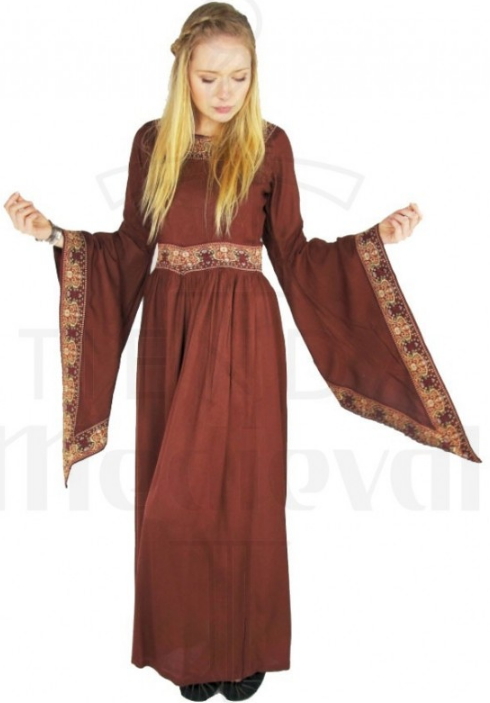
A Legacy of Elegance and Status in Medieval Women’s Dresses
Medieval fashion, with its wealth of materials, the vibrancy of its colors, and the complexity of its designs, was a direct reflection of the stratified society of the time. Every garment, from the simple peasant’s tunic to the sumptuous saya of the court lady, told a story of status, gender, and the prevailing cultural values. Looking at our own wardrobe today, we can reflect on how clothing remains a powerful form of communication and expression—a fascinating legacy from those times.
If you are passionate about the history and elegance of this era, exploring medieval women’s dresses means immersing yourself in a world of tradition and sophistication. Discover how the opulence of medieval nobility can inspire your own style or be the key piece for a themed event. Fashion from the past teaches us that dressing is, and always has been, a form of art and an expression of our identity.
DISCOVER BEAUTIFUL MEDIEVAL DRESSES FOR WOMEN
EXPLORE ELEGANT MEDIEVAL CLOTHING FOR MEN, WOMEN AND CHILDREN

